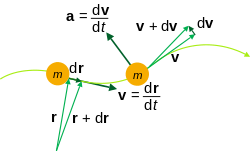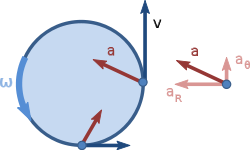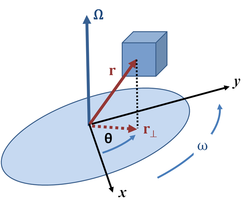Kinematics
Kinematics is the branch of classical mechanics which describes the motion of points, bodies, or objects, and systems of bodies, or groups of objects, without looking at the cause of this motion.[1]
Etymology
The word was translated from French. A.M. Ampère used the word cinématique.[2] He constructed the term form the Greek κίνημα, kinema (movement, motion), derived from κινεῖν, kinein (to move).[3][4] The study of kinematics is often referred to as the geometry of motion.[5]
Overview
To describe motion, kinematics studies the paths of points, lines and other geometric objects in space, and some of their properties such as velocity and acceleration. Astrophysics uses kinematics to describe the motion of celestial bodies and systems.
Applications
Mechanical engineering, robotics and biomechanics use it to describe the motion of systems composed of joined parts such as an engine, a robotic arm or the skeleton of the human body.[6] The study of kinematics can be abstracted into purely mathematical functions. It is possible to represent rotation with elements of the unit circle in the complex plane. Other planar algebras are used to represent the shear mapping of classical motion in absolute time and space and to represent the Lorentz transformation of relativistic space and time.
Mathematicians have developed a science of kinematic geometry, which uses time as a parameter. Some geometric transformations, called the rigid transformations, have been developed to describe the movement of components of a mechanical system. Such transformations simplify the derivation of its equations of motion and is central to dynamic analysis.
Kinematic analysis is the process of measuring the kinematic quantities[clarification needed] used to describe motion. In engineering, kinematic analysis may be used to find the range of movement for a given mechanism. Reversely, kinematic synthesis enables the design of a mechanism for a desired range of motion.[7] In addition, kinematics applies algebraic geometry to the study of the mechanical advantage of a mechanical system.[clarification needed]
Kinematics Media
Figure 1: The angular velocity vector Ω points up for counterclockwise rotation and down for clockwise rotation, as specified by the right-hand rule. Angular position θ(t) changes with time at a rate ω(t) = dθ/dt.
Illustration of a four-bar linkage from Kinematics of Machinery, 1876
References
- ↑
- Edmund Taylor Whittaker (1904). A Treatise on the Analytical Dynamics of Particles and Rigid Bodies. Cambridge University Press. Chapter 1. ISBN 0-521-35883-3.
- Joseph Stiles Beggs (1983). Kinematics. Taylor & Francis. p. 1. ISBN 0-89116-355-7.
- Thomas Wallace Wright (1896). Elements of Mechanics Including Kinematics, Kinetics and Statics. E and FN Spon. Chapter 1.
- ↑ Ampère, André-Marie (1834). Essai sur la Pilosophie des Sciences. Chez Bachelier.
- ↑ Merz, John (1903). A History of European Thought in the Nineteenth Century. Blackwood, London. p. 5.
- ↑ O. Bottema & B. Roth (1990). Theoretical Kinematics. Dover Publications. preface, p. 5. ISBN 0-486-66346-9.
- ↑ See, for example: Russell C. Hibbeler (2009). "Kinematics and kinetics of a particle". Engineering Mechanics: Dynamics (12th ed.). Prentice Hall. p. 298. ISBN 978-0-13-607791-6., Ahmed A. Shabana (2003). "Reference kinematics". Dynamics of Multibody Systems (2nd ed.). Cambridge University Press. ISBN 978-0-521-54411-5., P. P. Teodorescu (2007). "Kinematics". Mechanical Systems, Classical Models: Particle Mechanics. Springer. p. 287. ISBN 978-1-4020-5441-9.
- ↑ A. Biewener (2003). Animal Locomotion. Oxford University Press. ISBN 019850022X.
- ↑ J. M. McCarthy and G. S. Soh, 2010, Geometric Design of Linkages, Springer, New York.








